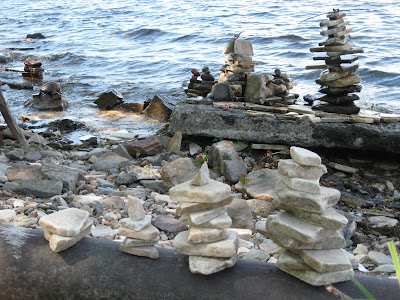
Intrigued by an article in the paper, the kids and I went down to the waterfront yesterday morning to check out the Andy Goldsworthy-esque sculpture a couple of 19- and 20-year-olds made with rocks. Most of it consisted of piles made of the unusually flat rocks down by the waterfront:

My favorite part was this path into the lake:

S decided to add his own contribution:

In addition to stone, it also incorporated a fair amount of the rusty metal bits that litter Burlington's once-industrial waterfront:

* * *
Burlington's waterfront was not always primarily a tourist destination — in fact, it was fairly industrial up until the seventies. In the 19th century, the waterfront was a huge transportation hub — Burlington was built on a bay which made it ideal for shipping goods on Lake Champlain, either north to Quebec or south to New York, and soon enough the railways came as well — just inland from where this sculpture is there is still a huge switching yard.
Vermont's economy in the 19th century was powered by resource extraction: timber, granite, marble. In the days before refrigeration made commercial dairy farming possible, commercial agriculture meant sheep farming — Vermont is actually more forested now than it was 150 years ago, as land formerly dominated by grazing sheep became reforested. Industrial production meant woolen mills. The built environment of Burlington and neighboring Winooski is dominated by 19th century mill buildings, some turned into condos and offices and boutiques, some converted to heavier industrial use in the twentieth century and now abandoned and toxic.
Like poor rural areas historically, Vermont soon attracted industry as a low-wage, non-union alternative to production in Massachussetts, New York or Connecticut. In the 1940s, organizers for the UE — the CIO union with jurisdiction for machine tool manufacturing — found machine tool factories in Springfield and Windsor where workers were making a fraction of their counterparts elsewhere in the Northeast.
Of course the bosses moved the work to poorer and more rural areas, especially after workers successfully organized. Vermont's industry moved to the US South, to Mexico, to China. And as Vermont de-industrialized, the economy turned to that other mainstay of poor rural areas (at least the picturesque ones), tourism.
By the seventies, it was clear that the potential beauty of Burlington's de-industrializing waterfront could make people wealthy. Whether development of the waterfront would be primarily public or private was one of the key issues in the 1981 mayoral race, in which the then-more-socialist-than-he-is-now Bernie Sanders broke the grip of a corrupt Democratic Party machine on Burlington's city government, running in part in opposition to a plan to develop the waterfront as private condos. As a result, we now have a public bikepath that spans the length of Burlington's waterfront, a public boathouse and large public park at the center of the bay (right by downtown), a science-and-ecology museum, and some other stray amenities such as an off-leash dog park and a skatepark, all with stunning views of the lake and, across the lake in New York, the Adirondacks. All this public land, together with the downtown pedestrian mall (also a product of Sanders' municipal socialism), no doubt create far more economic activity for local businesses than condos for the wealthy would have (there are still condos for the wealthy; they're just set back behind the public parks).
* * *

While the bike path runs along the whole waterfront, not all of it is developed. South of downtown, the bikepath runs for about a mile along the edge of the lake, while just east of the path is an industrial and former-industrial area of railyards, water sewage treatment, trucking terminals and brownfields, and at least one Superfund site. You can't get from the bikepath back to the rest of the city during this mile stretch, and the actual "beach" of small rocks where the water meets the land is filled with rusty metal.
Just south of the water sewage treatment plant (and just north of the temporary sculpture above), there is an odd, and more permanent, piece of public art which commemorates the fact that white marble was found and dug at this spot, and in fact that marble was used — along with other rock — to stabilize and create the Burlington waterfront. Several large pieces of marble are placed along the waterfront, seemingly at random, and some of them carved to look, presumeably, like the detritus of some ancient civilization, both the strange mythical lake creatures that they worshipped:

... and the curious devices that they used for transportation:

No comments:
Post a Comment